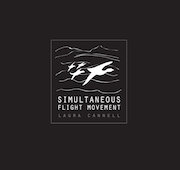At certain times of the year, one of the most spectacular sights to behold (if you’re lucky enough to find yourself in Britain’s East Anglia) is the flocking of birds along the coast. As if guided by an overseeing hand, swallows or sea birds gather in vast numbers, seemingly describing images and shapes in the sky (different depending on which sort of birds you witness, of course). Bird flight is the overarching theme of Norfolk-based fiddler and recorder-player Laura Cannell, as outlined by the very titles of her albums, from her stunning 2014 debut Quick Sparrows over the Black Earth to this latest work, Simultaneous Flight Movement, with her semi-improvised takes on medieval folk mirroring the swoops and flurries of local bird life.
Quick Sparrows… was centred on the relationships between birds and the land, and was therefore more overtly folky, while its follow-up, Beneath Swooping Talons captured the underlying tensions and violence of birds of prey. Simultaneous Flight Movement, which tracks the flights of coastal avians, is more elaborate and allusive than those two albums, Cannell’s bow slides and recorder notes tracing the outlines of wings and the movement of bodies. Most intriguing is her work on dual recorders, an unusual musical approach these days: on the two previous albums, the tracks featuring recorders were almost abrasive, applying the structure of free improv as much as anything. Here, the focus is on melody, elevating this most underappreciated of instruments to the elegance of a flute or trumpet on tracks like ‘The Happiness of Both Worldes’ and ‘Interrelations of Diverse Emotions’. Cannell also takes a bold step in opening with the recorders on ‘Winter Saltings’, the trilling notes echoing the songs and calls of starlings or larks.
Fiddle remains Cannell’s instrument of predilection, however, and her use of it is as idiosyncratic as with the recorders, often loosening the strings of the bow to slide it over the fiddle’s neck. The resultant overbowed notes are deeply resonant, with an almost harmonium-like droning undercurrent. ‘Horselore’ builds and builds skywards, whilst “A New Theory of Eclipse” is more swooping, with the notes seesawing in and out of focus. Again, bird metaphors abound, but one can just as easily drink in this music without any context. Much is made of the contextuality of “historic” music of the sort played by Cannell, but she projects it into a broader continuum that feels both ancient and modern at once, from the haunting folk of ‘Sheltering Hollows’ to the improv and jazz flourishing that dominate on ‘A New Theory of Eclipse’ and ‘Three Stones’.
Just as crucial to the music is where it was recorded: Laura Cannell created (“recorded” feels too technical for music this organic) Simultaneous Flight Movement in one take, live, inside a 19th-century lighthouse in the Suffolk town of Southwold, and the cold air and the empty vastness of the space both contribute to the resonance and slight intangibility of her work, amplifying both fiddle and recorders as the notes echo through the ether. It also adds to the sense of location and place, as anyone familiar with that part of the world will have a mind’s eye vision of the expansive coastline, choppy seas and, yes, the birds.
Comparing Simultaneous Flight Movement to either of Laura Cannell’s previous albums would be inappropriate because her body of work needs to be taken as a whole broken into chapters rather than a series of missives, but it represents another step on a fascinating, rich and unique musical journey.


